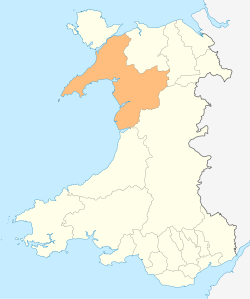
Ynys Gifftan is an island near the south east shore of Traeth Bach, the Dwyryd estuary near Portmeirion in Gwynedd, north Wales. There is a public footpath to it across the estuary marked on Ordnance Survey maps but has no definable marks that make it obvious; it can be reached on foot at low tide and is 38 metres (125 ft) high. [1] Although there is a footpath to the island, the island itself is private property and trespassing is not advised. The island has been uninhabited since the mid-1960s and the island's single cottage is in a state of disrepair. [2] It is one of 43 (unbridged) tidal islands which may be reached on foot from the mainland of Great Britain. [3]
